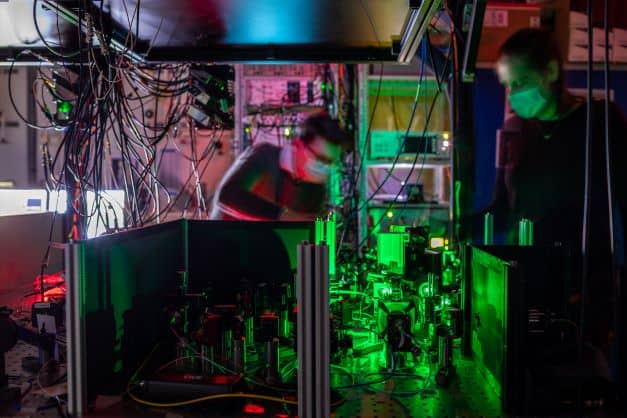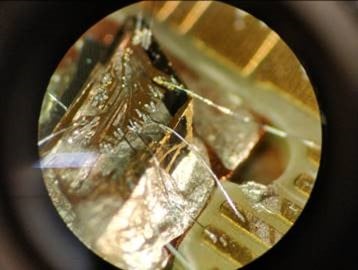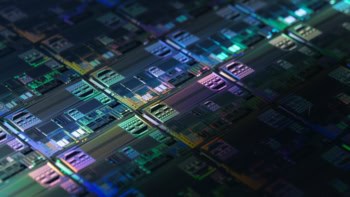
Physicists in the Netherlands have shown for the first time that quantum information can be reliably teleported between network nodes that are not directly connected to each other. According to the researchers, who created the world’s first three-node quantum network at QuTech (a collaboration between the Delft University of Technology and TNO) in 2021, the latest work marks a further step towards a scalable quantum Internet.
Quantum networks offer a super-secure way of transferring information between different locations, or nodes. While these nodes can be connected using ordinary optical fibres, photon losses within the fibres limit the quality, or fidelity, of the connection: when a photon is lost, its quantum information is lost, too. Using quantum entanglement to teleport information directly from one node to another removes this loss mechanism, making it desirable for a future quantum Internet.
The three-node network demonstrated at QuTech in 2021 used quantum bits, or qubits, made from nitrogen-vacancy (NV) centres, which are defects within diamond’s lattice of carbon atoms. Each node contained a communication qubit, and one node also incorporated a memory qubit (made from an adjacent carbon atom) that could store the node’s quantum information. The building blocks for entangling three nodes were thus already present, but the system was far from reliable at teleporting states consistently.
Quantum teleportation
The first step in teleporting quantum information from a sender to a receiver is to establish entanglement between their respective qubits. Performing a so-called Bell state measurement (BSM) on the sender’s qubit causes its quantum state to teleport – meaning that it disappears from the sender’s node and appears, in encrypted form, at the receiver’s node. The quantum state can then be decrypted using the BSM outcome that is sent to the receiver via a classical channel (such as an optical fibre).
Previously, this had only been done with two adjacent network points, traditionally called Alice and Bob. Adding a third point, Charlie, is no easy task, as the entanglement between Alice and Charlie needs to be created via Bob, the intermediate node. It also requires a high fidelity to make the teleportation functional.
Optimization steps
To achieve this high fidelity, the QuTech researchers carried out several upgrades. In their previous system, the “heralding” signals that indicate entanglement came from the same photodetectors that detected the photons used for entanglement. This, however, can lead to false heralding signals due to various undesired processes generating a second photon. To avoid this, the team set up an additional detection path that flags the false heralding signals by catching the second photon.

Another problem the researchers addressed is spectral diffusion, which causes the qubits to come out of phase, lowering the fidelity of transmission. This process has more impact for photons emitted at later times, so the team shortened the detection window.
A final set of improvements concerned the memory used to store quantum information. First, the team protected the memory qubit from interactions with neighbouring nuclear spins. To do this, they integrated a magnetic field pulse into the entangling sequence that flips the memory qubit at set time intervals, thereby averaging out the effects of these unwanted interactions. They also improved their ability to read the memory qubit. Because one of the memory qubit’s states has a more favourable fidelity, its readout is not symmetric. By repeating the readout process, the team filtered out “bad” readouts, ultimately increasing the fidelity.
Beam me up
Following these improvements, the researchers were able to teleport quantum information between the non-adjacent nodes of Charlie and Alice. First, they entangled Alice’s qubit and Charlie’s via Bob’s. Charlie then stored its part of the entangled state at its memory qubit and prepared the quantum state to be teleported. Applying the BSM at Charlie teleports the state to Alice. The researchers then sent the BSM outcome to Alice and retrieved the state with a fidelity of 71% – higher than the classical bound of ⅔, proving that the teleportation was successful.
Ronald Hanson, the QuTech researcher who led the study, says that the team’s next step will be to expand the number of memory qubits, making it possible to run more complex protocols. Another objective is to get the technology working outside a lab environment, for example by using already-deployed optical fibres within a real network. “We are also cooperating with computer scientists to develop the quantum network control stack – a similar stack of control layers that currently run the Internet we all use today,” he tells Physics World.
Hugues de Riedmatten, a researcher at ICFO in Barcelona, Spain, who was not involved in the study, says that quantum teleportation over non-neighbouring nodes is a significant milestone. In his view, the team’s biggest achievement was to combine several challenging experiments – all of which need to be fully optimized to reach the required fidelity for quantum teleportation – into a single demonstration. de Riedmatten notes that the current set-up can use only a small percentage of the emitted photons, which limits its remote entanglement rate. However, he adds that this could be fixed by embedding the NV centres in an optical cavity to collect more photons, or by using other emitters.

Three-node quantum network makes its debut
Rodney Van Meter at Japan’s Keio University also praises the work, describing it as the fundamental difference between a simple channel connecting two parties and an actual network. One of the difficulties, he notes, will be to scale up to large numbers of qubits at each node, but other teams around the world have been working on this problem for NV-centre qubits. With the Delft team already planning to increase the number of nodes in its network, he is, he says, “looking forward to seeing what they produce next”.
The research is described in Nature.



